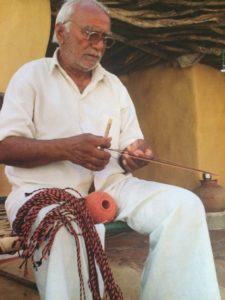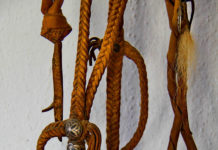In the past decorative accessories were crafted for animals serving the courts and temples with special armour fitted for those that served in battle. Among the humbler and more domestic traditions of utilitarian adornment is the continuing though endangered custom of braiding girth-belts for camels (tang) in the desert region of Thar in Jaisalmer, Rajasthan.
 Prized for its strength, longevity and aesthetic appeal the girth-belt serves to keep the saddle firmly in its place. Braided by members of the Bhatti Rajput camel-herding community, traditional girth-belts are made of yarn spun from goat hair and constructed by the split-ply braiding technique. The most valued have figures, motifs and geometric detailing inspired by desert life.
Prized for its strength, longevity and aesthetic appeal the girth-belt serves to keep the saddle firmly in its place. Braided by members of the Bhatti Rajput camel-herding community, traditional girth-belts are made of yarn spun from goat hair and constructed by the split-ply braiding technique. The most valued have figures, motifs and geometric detailing inspired by desert life.
The process starts with cleaning goat hair and spinning it into yarn using a drop spindle, the dhera. Usually six feet long and about five inches wide, the girth-belt needs about 30 to 40 strands of 9-hand lengths of 4-ply yarn. The tool of the trade is a hooked-needle (gunthani) made by the braiders out of locally available softwood. Flattened to a broad point at one end with an eye to accommodate the yarn, the braiders constantly manipulate it to maintain an even tension. The split-ply technique creates patterns by oblique interlacing, changing yarn direction, and splitting yarns. When the required length has been reached the belt is knotted with decorative tassels and accessorised with small cloth balls called jhoom.
Among the few remaining practitioners are members of the family of the late Ishwar Singh Bhatti who brought the craft into prominence in the early 1970s. They are determined to carry forward the tradition in spite of stiff competition from low-cost synthetic replacements.




Since ISHWAR Singh Bhatti was nominated by NID and was the first recipient of the national award decades ago .
Has another Craftsperson been located ?
If Yes , I would like to know the details of the CRAFTSPERSON. The unsung masters have to be found and celebrated .
Regards
EP